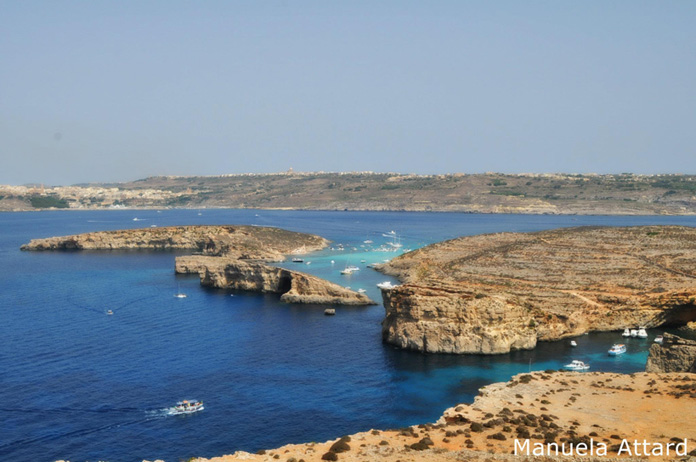| |
| Schedule & Pricing |
| Buy Tickets |
| Directions |
| About Comino |
| About Blue Lagoon |
| St. Mary's Tower |
| St. Mary Battery |
| Weather |
| Live WebcamPhoto Gallery |
| Terms & Conditions |
| FAQ's |
| Contact us |
About Comino |
||
Comino (Maltese: Kemmuna) is an island of the Maltese archipelago between the islands of Malta and Gozo in the Mediterranean Sea, measuring 1.35 sq. miles in area. Named after the cumin herb that once flourished on the Island, Comino is noted for its tranquility and isolation. It has a permanent population of only four residents. One priest and one policeman commute from the nearby island of Gozo, to render their services to the local population and summertime visitors. Today, Comino is a bird sanctuary and nature reserve. Administratively it is part of the municipality of Għajnsielem, in southeastern Gozo. |
||
| History of Comino | ||
Comino is known to have been inhabited by farmers during Roman times, however for long periods in its history it has been sparsely populated, or abandoned entirely. Its rugged coastline is delineated by sheer limestone cliffs, and dotted with deep caves which were popular with pirates and marauders in the Middle Ages. The caves and coves of Comino were frequently used as staging posts for raids on hapless boats crossing between Malta and Gozo. In later years, the Knights of Malta used this island as hunting and recreational grounds. The Knights were fiercely protective of the local game, which consisted of wild boar and hares (Maltese: fenek tal-grixti): upon conviction, poachers were liable to a penalty of three years as a galley slave. In the 16th and 17th centuries, Comino served as a place of imprisonment or exile for errant knights. Knights who were convicted of minor crimes were occasionally sentenced to the lonely and dangerous task of manning St. Mary's Tower. |
||
 |
||
| View of Comino (right), Cominotto (large island on left) and other smaller islands, with Gozo in the background. Photo taken by Manuela Attard from atop the St. Mary's Tower. Click the photo to enlarge. | ||
| Other Building and Structures | ||
A tiny Roman Catholic chapel dedicated to the Sacred Family Upon its Return from Egypt is located above Santa Marija Bay. Built in 1618, and enlarged in 1667 and again in 1716, the chapel was originally dedicated to the Annunciation. It has been desecrated and reconsecrated at least once in its history, when Comino was devoid of residents. The earliest record of a chapel on this site dates back to the 12th century, and can be seen in a navigational map of the period, located in the National Maritime Museum and Royal Observatory in Greenwich, London. Mass is celebrated in the chapel on Saturday nights and Sunday mornings for the residents, hotel staff and tourists. St. Mary's Battery, built in 1716, at the same time as various other batteries around the coastline of mainland Malta, is situated facing the South Comino Channel. It is a semi-circular structure with a number of embrasures facing the sea. The Battery still houses two 24-pound iron cannons, and remains in a fair state of preservation mainly due to its remote location. Its armament originally included four 6-pound iron cannons. The Battery underwent restoration in 1996 by the Maltese heritage preservation society, Din l-Art Ħelwa. St. Mary's Redoubt, an additional defensive structure, was also constructed in 1716 on the northern coast of Comino, however it was subsequently demolished. The Knights also constructed army barracks on Comino. In the early 20th century the barracks were periodically used as an isolation hospital. Comino Hotel, with its two private beaches, a 1960s development, is located above San Niklaw Bay. There are also holiday bungalows by Santa Marija Bay. The only other commercial enterprise on Comino was a pig farm, now closed, which was located on the remote, south east corner of the Island. Its purpose was to engage in selective breeding after all pigs in Malta were destroyed to stop an epidemic of foot and mouth disease. There is a police station located between the holiday bungalows and the chapel. |
||
| Interesting Facts and Folklore | ||
|
||
| Tourism and Film Industry | ||
Between Comino and adjacent islet of Cominotto (Maltese: Kemmunett) lie the transparent, cyan waters of the Blue Lagoon (Maltese: Bejn il-Kmiemen, literally "Between the Cominos"). Frequented by large numbers of tourists and tour boats daily, the Blue Lagoon is a much photographed, picturesque bay, with a brilliant white, sandy base, and a rich marine life that make it popular with divers, snorkelers and swimmers. Other beaches on Comino include St. Mary Bay (Maltese: Ramla ta' Santa Marija) and St. Nicholas Bay (Maltese: Bajja San Niklaw). Comino is a popular location for filmmakers. It appears in the movies Troy, The Count Of Monte Cristo and Swept Away. Most notably, St. Mary's Tower on Comino was featured in the film The Count of Monte Cristo, where it doubled as the Château d'If. |
||

| ADDITIONAL SERVICES | ||
|
||
Contents ©2010 Comino Ferries Co-op


